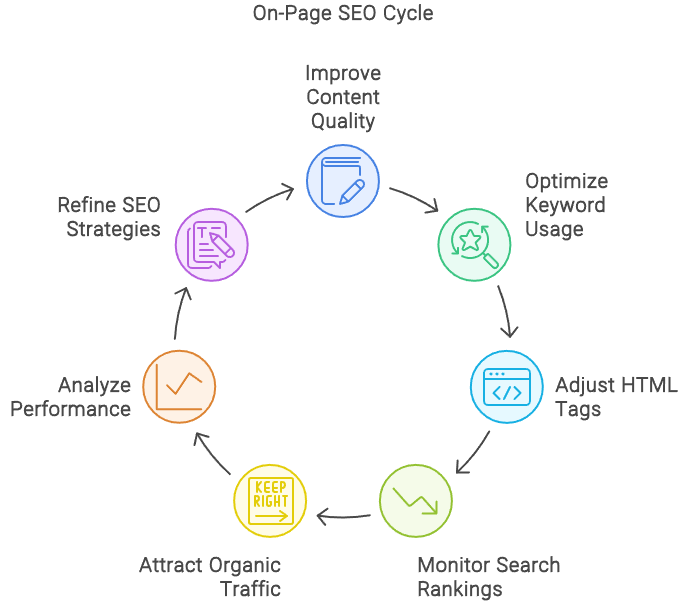Basics of On-Page SEO

Understanding On-Site SEO
On-page SEO, also referred to as on-site SEO, is the practice of optimizing individual web pages to enhance their visibility and ranking in search engines. This process is fundamental for informing Google and other search engines about the content of your site. Optimizing both the content and the HTML source of a page allows search engines to understand its value to visitors and customers (SEMrush Blog).
Here are some key components of on-site SEO:
| Component | Description |
|---|---|
| Title Tags | Tell search engines the topic of a web page. |
| Meta Descriptions | Provide a summary of the content and its value. |
| Header Tags | Structure the content for better readability. |
| URL Structure | Help indicate the hierarchy and organization of content. |
A well-structured webpage uses these elements to provide a clear pathway for users and search engines alike.
Importance of On-Page Optimization
On-page optimization is critical for several reasons. It not only aids in improving your search rankings but also enhances the user experience. Google emphasizes the importance of “people-first content,” meaning your content should be valuable and relevant to users (SEMrush Blog).
Here are some reasons you should prioritize on-page optimization:
| Reason | Explanation |
|---|---|
| Higher Rankings | Optimized pages rank better in search results. |
| Increased Organic Traffic | More visibility leads to more visitors. |
| Enhanced User Experience | Better content structure improves navigation. |
| Reduced Bounce Rates | Engaging content keeps visitors on your site longer. |
Avoid black hat SEO practices, such as keyword stuffing and hiding text, as these can lead to penalties from search engines (HubSpot). Instead, focus on delivering high-quality content that aligns with user intent. This strategy not only helps in achieving better rankings but also builds credibility with your audience.
To further refine your on-page methods, consider our resources on seo optimization best practices and seo site audit checklist. Optimize for mobile by checking our guide on mobile optimization for websites.
Keyword Optimization

Effective keyword optimization is essential for enhancing your online visibility and attracting organic traffic. This section will guide you through keyword research strategies and how to target the right keywords effectively.
Keyword Research Strategies
Understanding what your audience is searching for is critical. Keyword research allows you to determine the terms and phrases relevant to your business. Here are some effective strategies for conducting keyword research:
- Identify Your Audience: Know who your target audience is and what challenges they face. This insight will guide your keyword selection.
- Use Keyword Tools: Tools such as Google Keyword Planner, Ahrefs, or Semrush can help you find keywords with good search volumes and low competition.
- Perform a Keyword Gap Analysis: Utilizing tools like Semrush’s Keyword Gap tool allows you to discover keywords that your competitors rank for but you do not. This analysis provides valuable insights to fill any gaps in your keyword strategy (Semrush Blog).
- Analyze Search Intent: Match keywords with user intent, whether it’s transactional, informational, or navigational. This ensures that your content meets the needs of those searching.
- Map Your Keywords: Keyword mapping involves matching each target keyword with the corresponding page on your site that addresses its search intent. This can enhance planning and optimize your content effectively (Semrush Blog).
| Strategy | Purpose |
|---|---|
| Identify Your Audience | Understand target demographics and needs |
| Use Keyword Tools | Discover high-potential keywords |
| Perform Keyword Gap Analysis | Find missed opportunities against competitors |
| Analyze Search Intent | Align content with user needs |
| Map Your Keywords | Optimize content for better SEO results |
Targeting the Right Keywords
Once you have a list of keywords, the next step is to prioritize which ones to target. Here are some tips for effectively targeting the right keywords:
- Focus on Relevance: Choose keywords that are directly relevant to your content and services. This ensures that traffic is more likely to convert.
- Consider Search Volume and Competition: Aim for keywords that have a balance between high search volume and manageable competition.
- Long-Tail Keywords: Incorporate long-tail keywords, which are more specific and often less competitive. These keywords can attract very targeted traffic and have higher conversion potential.
- Monitor and Adjust: Regularly check the performance of the keywords you target. Use analytics tools to see which keywords are driving traffic and conversions, and adjust your strategy accordingly.
- Optimize Title Tags and Meta Descriptions: For each optimized page, ensure that the primary keyword appears in the title tag (55-64 characters is optimal) and the meta description to improve click-through rates (Advanced Web Ranking).
| Criteria | Recommended Actions |
|---|---|
| Relevance | Select keywords aligned with your content |
| Search Volume | Balance between high volume and competition |
| Long-Tail Keywords | Utilize specific phrases for targeted traffic |
| Monitor Performance | Adjust strategy based on data analysis |
| Optimize Tags | Incorporate keywords into title and meta descriptions |
By applying these on-page SEO optimization techniques, you will enhance your website’s visibility and increase the likelihood of attracting your desired audience. Don’t forget to utilize SEO optimization best practices to further strengthen your overall strategy.
Content Optimization

Optimizing your content is a pivotal part of any successful SEO strategy. It helps improve your website’s visibility in search engines and ensures that you attract the right audience. Below are key strategies to create valuable content and structure it effectively.
Creating Valuable Content
To enhance your search engine rankings, focus on writing unique and helpful content. Start by performing thorough keyword research to identify relevant topics and target keywords. It’s often beneficial to target less competitive long-tail keywords, which can be easier to rank for (SEMrush Blog).
Here’s a table highlighting the essential elements of valuable content:
| Content Element | Description |
|---|---|
| Unique Insights | Offer original perspectives or solutions. |
| Problem-Solving | Address specific challenges faced by your audience. |
| Engaging Format | Use headings, lists, and visuals to break up text. |
| Clear Calls to Action | Encourage readers to take action, such as signing up for newsletters or exploring products. |
Incorporating target keywords strategically in your content, title tags, and meta descriptions is crucial for effective on-page SEO. Important places to optimize include titles, descriptions, headings, and even image alt text (HubSpot). This helps Google understand the topic of your page and match it with user search intent effectively.
Structuring Your Content Effectively
A well-structured piece of content not only enhances readability but also benefits SEO performance. Proper structure allows search engines to crawl and index your pages more efficiently. Here are some best practices for structuring your content:
- Use Headings and Subheadings: Break your text into sections using appropriate headings (H1, H2, H3). This not only improves reader experience but also lets search engines understand the hierarchy and main topics of your content.
- Include Meta Tags: Well-crafted meta descriptions can improve click-through rates. Ensure your meta descriptions encapsulate the essence of your content while including target keywords (Semrush).
- Add Internal Links: Link to other relevant pages on your site. This not only keeps users engaged but also guides search engines through your website, enhancing indexing.
- Optimize Visual Content: Use image alt text to describe images and incorporate target keywords where relevant. This helps improve your visibility in image searches.
- Consider User Experience: Ensure your website layout is user-friendly. A seamless navigation experience encourages visitors to stay longer, which can positively influence your SEO rankings.
For more information about enhancing your website, consider exploring our seo optimization best practices and seo site audit checklist. Proper content optimization is a continuous process that can significantly impact your site’s performance in search engines when executed correctly.
Technical Optimization

Technical optimization is a crucial aspect of on-page SEO that focuses on improving the infrastructure of your website. This ensures that search engines can crawl and index your site effectively. In this section, we will explore key HTML elements for SEO and how to enhance site performance to boost your online presence.
HTML Elements for SEO
Meta tags are essential HTML elements that provide information about your web pages to search engines and users. They are located in the <head> section of your page. Optimizing these tags can significantly influence your search visibility and click-through rates. Here are some important meta tags you should focus on:
| Meta Tag | Purpose |
|---|---|
| Meta Description | Summarizes the content of the page; influences how your page appears in search results. A well-crafted description can attract more traffic. Learn more |
| Meta Robots | Controls the behavior of search engines regarding page indexing. For instance, using “noindex” prevents a page from appearing in search results. Appropriate usage is critical for SEO. Learn more |
| Viewport Meta Tag | Adjusts how your webpage is displayed on mobile devices, which is vital since Google considers user experience in its rankings. Learn more |
By optimizing your meta tags with relevant keywords and unique selling points, you can enhance your site’s visibility and draw in qualified traffic. Additionally, ensure that you avoid using incorrect tags like “nofollow” on internal links, as this can negatively impact your site’s SEO.
Enhancing Site Performance
Improving your website’s performance is essential for user experience and search engine rankings. A well-performing website not only retains visitors but also encourages them to explore more pages, thereby increasing engagement and reducing bounce rates.
Here are several strategies to enhance site performance:
- Optimize Loading Speed:
- Aim for a loading time of under 3 seconds. Site performance affects both user experience and search engine rankings.
- Tools such as Google PageSpeed Insights can help you identify areas for improvement.
- Mobile Optimization:
- Ensure your site is mobile-friendly by utilizing responsive design techniques. A significant portion of web traffic comes from mobile devices. Check your site’s mobile optimization status on our page for mobile optimization for websites.
- Reduce Image Sizes:
- Compress images without compromising quality to improve loading speeds. Use formats like WebP for better performance.
- Leverage Browser Caching:
- Use caching to store frequently accessed website data, which significantly speeds up load times for returning visitors.
- Implement a Content Delivery Network (CDN):
- A CDN can speed up access to your site by storing copies of your content across multiple server locations worldwide.
Regularly conduct an SEO site audit checklist to identify and fix any technical issues hindering your site’s performance. By focusing on these technical aspects, you can ensure that your website is not only user-friendly but also optimized for search engines, ultimately leading to improved visibility and traffic.

